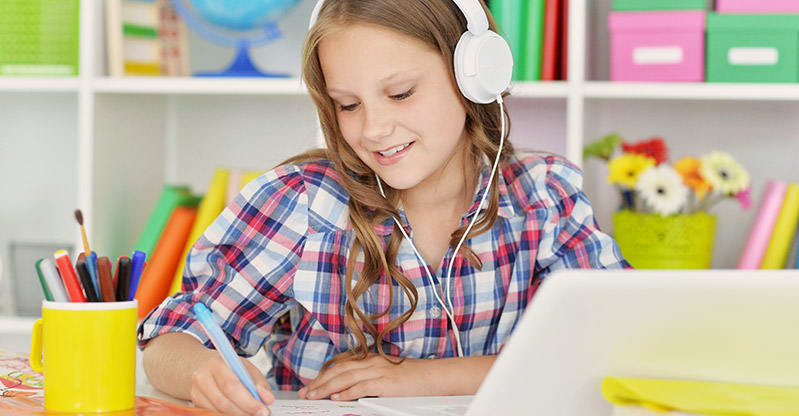Parents are often cautioned about the dangers of screen time for children, but what if screen time could be good? And what does that mean for e-learning? Is it good, or bad for kids?
What is e-learning?
E-learning is simply any learning that is delivered electronically rather than in person. A long time ago, e-learning meant “online courses,” but these days the definition covers much more technology.
“E-learning for kids” can mean any technology or online learning that helps kids learn, from educational websites, to videos to course providers, to mobile and educational apps.

Who can benefit from e-learning for kids?
Any family can benefit from e-learning that’s specifically aimed at children. One of the most practical things for both parents and schools is that e-learning is often used to supplement a child’s existing education. For example, children may receive online time or watch videos at school to teach certain skills, or as one of a few learning stations.
Children might also do e-learning at home to help them with subjects they’re having trouble with, or to give them a class they can’t find in school or in the area. (Such as scratch programming, app development for kids, a YouTube course for kids, or robotics for kids.)
E-learning may also be valuable to homeschool families. It’s difficult to get statistics that reflect the number of homeschooled students worldwide, but many parents worldwide have embraced homeschooling. To name just a few of the countries for which there are numbers available, there are tens of thousands of Canadian homeschooled students, 1.6 million U.S. homeschooled students, 48,000 homeschooled students in the U.K., and 100,000 students being homeschooled in South Africa. Homeschooling parents can’t do it all — they may have some online support to teach subjects like science and math. E-learning technology can also play an important role in rounding out their program.
The best e-learning sites for kids: math
Math is a subject that can make the blood run cold for both children and adults. This is especially true since many schools are changing the way they teach mathematics and parents may feel at sea when they try to help their families with homework for school.
E-learning to the rescue: these applications and sites will help your kids (and you) learn math. And surprise: you might even have fun learning it.
Quick Maths
Quick Maths is an app aimed at kids aged 6-10, but the app can be used by an older user as well. Quick Maths gets kids comfortable learning numbers and basic math problems, teaches mathematical concepts and lets them solve problems as they race the clock. Looking for free e-learning? Good news: The Quick Maths app is free, although it offers relatively inexpensive in-app purchases.
CoolMath
If you’re looking for free e-learning for kids and help with math, you might like CoolMath and its companion site CoolMath4Kids. Launched in 1997, CoolMath offers math for “ages 13-100″ covering subjects including algebra, pre-calculus and other complex math subjects. Coolmath4kids is devoted to math games, quizzes, manipulatives, and puzzles for kids 12 and under. Best of all, all the math sites under the CoolMath umbrella (which includes CoolMath4Parents and CoolMath-Games) are free.

The best e-learning sites for kids: science
Does your child have a lot of questions about the world around them? Do they ask you a lot of questions about it? If so, (and you simply can’t answer one more question about supernovas or tardigrades) technology can help.
While there are several adult-oriented apps and sites that can help (our household favorites include NASA’s App and the Cornell Lab of Ornithology’s Merlin Bird ID), there are more appropriate e-learning websites for kids. With these, your kids will be answering your questions.
Science 360
Science 360 is a free app, created by the National Science Foundation and updated weekly. Previous versions ran only on tablets, but now the app works on phones as well. Science 360 features hundreds of exciting videos and high-resolution photos from a dozen areas of science, so students can spend hours absorbed in discoveries that take them from the depths of space, to the wonders of the unimaginably small, to the far corners of our own planet. There’s also a 360-degree view (hence the name) that helps kids explore the images.
Edheads
Edheads is a membership-based site that has a large collection of interactive science-related activities that will keep children entertained. This includes games, puzzles and even events. This is a subscription-based service. Families pay $20 annually.

The best e-learning sites for kids: typing
Typing is an important skill for kids, who are expected to turn in typed papers and reports and who will likely go into careers that require typing (everything from writing prose to business, requires some skill with a keyboard.) Unfortunately, keyboarding isn’t always taught in school; some districts assume kids already know how to type.
E-learning can fill in those gaps by teaching typing and keyboarding skills online and making them fun.
Typing Instructor for Kids 5.0
This program takes your kid on an adventure, while teaching them to type quickly and accurately. With 160 lessons and 30 games, this software is a fun and comprehensive program your child will like. It’s also a traditional piece of software; it’s sold by Microsoft and uploaded onto your PC.
Jungle Junior
Jungle Junior is a free, interactive typing game for kids. Through the course of about 200 friendly, colorful videos and interactive lessons, kids will learn all about the alphabet and practice sight words, word families and simple sentences. It’s easy learning and it’s engaging.

Is e-learning a good way for a kid to learn?
While there is naturally a good deal of anxiety about the dangers of screen time for children, online education and e-learning can offer a lot of benefits for kids and families: e-learning can boost hand-eye coordination in younger children, for example, and it can connect older kids with other students all over the world.
Online learning and education also make “boring” subjects more fun with games and capture kids’ attention with bright colors and engaging graphics. These are traits e-learning shares with entertainment apps, so it’s natural that some parents would worry about e-learning being junk food for the brain.
That’s not necessarily true — the educational apps and courses above are highly-rated, showing that it’s the content that matters, not how it’s being delivered.





Interested and i would really love to see my kids learning that’s my vision